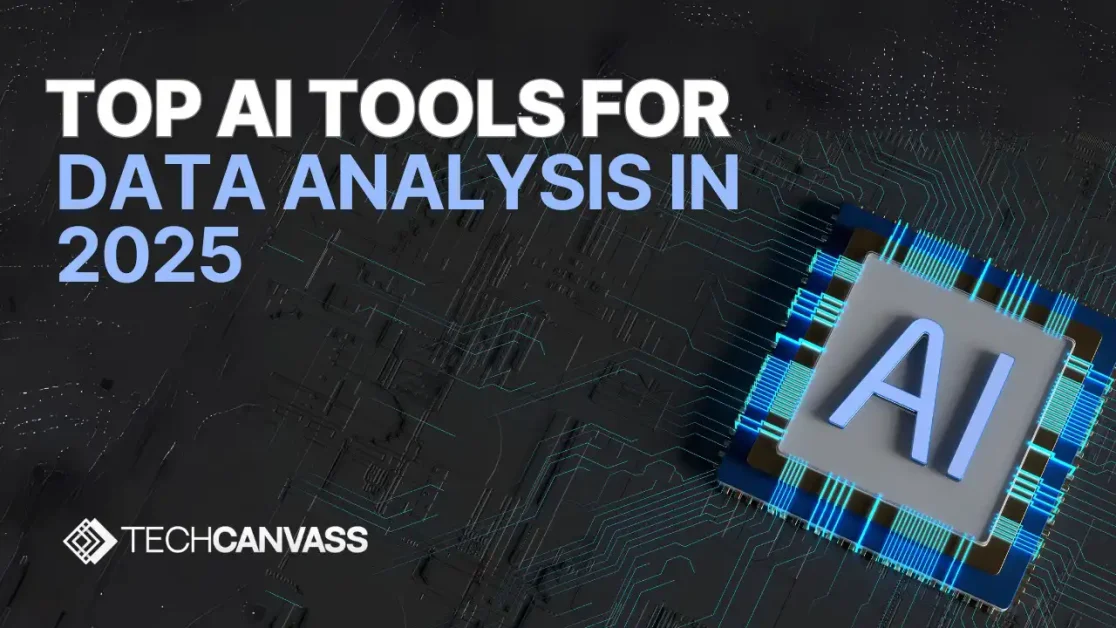Last Updated on September 17, 2025 by Techcanvass Academy
Table of Contents
Overview
Data analysis isn’t just about spreadsheets anymore. As business data is growing more complicated with each passing day, advanced methods for understanding it are required. Traditional methods of data analysis relied heavily on manual processes and required a lot of effort. Recently, we all know how AI and its tools have played a significant role in every field of study and data analysis is no different. There are so many great ai tools for data analysis which data analysts can use to extract valuable insights, automate repetitive tasks, and uncover hidden patterns in larger datasets. I’ve come across many such scenarios where by leveraging ai tools for data analysis, data analyst’s can now tackle complex problems more efficiently and with greater accuracy, revolutionizing the field of data analysis. In this article, we will explore the top AI tools for data analysis.
Benefits of AI in Data Analysis
Lets quickly see how AI can be beneficial for Data Analyst
- Cost Reduction: Salesforce has recently said that by implementing AI in their organization they were able to make significant cost savings. Same notion is echoed by other companies with 54% of businesses (Linkedin-2024) reporting reduced operational costs by using ai tools for data analysis.
- Time Efficiency:Remember the days when we stared at spreadsheets with huge amount data. Those days are gone. AI can tear through massive amount data in the time it takes a human to grab a coffee. It’s not about working harder anymore – it’s about working smarter.
- Enhanced Decision-Making: AI has transformed decision-making from a guessing game to a precision sport. No more gut feelings or crossed fingers, AI helps you make faster, more accurate, and innovative decisions.
Explore AI in data analysis with our AI Certification for Data Analysts and get Power BI training at our Power BI course. To better understand the evolving role of professionals in this field, check out who is an AI Data Analyst and how they leverage these tools for deeper insights.
Data Analysis Stages where you can use AI
- Data Cleaning: As a data analyst we all know how time consuming this task can be. There are specialized AI tools for data analysis that can automate the tedious process of data cleaning, identifying outliers, and normalizing data.
- Data Analysis: As a data analyst we all know how time consuming this task can be. There are specialized AI tools for data analysis that can automate the tedious process of data cleaning, identifying outliers, and normalizing data.
- Data Visualization: Business intelligence tools, which are enhanced with AI, can create interactive dashboards for deeper data exploration.
- Predictive Analytics: AI excels in generating accurate predictions based on historical data patterns.
- Data-Driven Decision Making: The use of AI insights leads to more informed decision-making and proactive problem-solving.
Top 6 AI Tools For Data Analysis
1. Tableau (Powered by Einstein Analytics)
Key Features:
- Visual Intelligence: Tableau uses AI to suggest the most appropriate visualizations based on your data structure. This means even junior analysts can create professional-grade dashboards within minutes.
- Predictive Analytics: Beyond simple charting, Tableau Einstein integrates machine learning to:
- Forecast future trends
- Identify hidden patterns
- Generate automated insights
- Provide statistical confidence intervals
- Natural Language Processing: Non-technical professionals can now ask questions in plain English, and Tableau will generate corresponding visualizations and insights. Ask questions like, “Show me sales by region last quarter,” and Tableau generates interactive dashboards instantly.
- Smart Anomaly Detection: Einstein Analytics flags unexpected patterns (e.g., a sudden 30% drop in website traffic) and suggests root causes. It automates repetitive tasks such as data cleaning and visualization formatting.
- Integration: Works seamlessly with SQL databases, Excel, Snowflake, and cloud platforms like AWS.
2. Microsoft Power BI + AI Insights
Next in line for top AI tools for Data Analysis is MS Power BI. Microsoft is trying to be the game changer with Power BI– it has launched a series of intelligent analytics ecosystem that integrates seamlessly with the Microsoft suite of products.
Key Features:
- Q&A Natural Language: Type, “What’s the correlation between ad spend and sales?” and Power BI generates charts.
- AutoML Integration: Build predictive models (e.g., customer churn) without coding.
- AI-Driven Insights: Automatically highlights trends (e.g., “Holiday sales spike linked to email campaigns”).
- Prebuilt AI Models: Sentiment analysis, image recognition, and forecasting.
Why It’s a Must-Have:
- Seamless Ecosystem: Integrates with Excel, Teams, and Azure for end-to-end workflows.
- Explains Why: The “Key Influencers” feature breaks down factors affecting metrics (e.g., “Price changes caused 60% of revenue drop”).
- Cost-Effective: Free version available for students and small teams.
Explore AI in data analysis with our AI Certification for Data Analysts and get Power BI training at our Power BI course. To better understand the evolving role of professionals in this field, check out who is an AI Data Analyst and how they leverage these tools for deeper insights.
3. Google Cloud AutoML
The best advantage of Google Cloud AutoML is that it makes advanced predictive modeling accessible to analysts without deep coding expertise.
Key Features:
- Custom Model Building: Train AI models for text, images, or tabular data without coding.
- Prebuilt APIs: Vision, Natural Language, and Translation APIs for quick deployment.
- Scalability: Handles small datasets (100+ samples) to enterprise-level data.
- No-Code ML: Perfect for analysts who lack ML expertise but need tailored solutions.
4. IBM Watson Analytics
IBM Cognos Analytics with Watson is one of the best visualization tool for discovering patterns and insights in your data that combines ease of use with high performance.
Key Features:
- Conversational Analytics: Ask questions like, “Why did profits drop in Q3?” and Watson provides plain-English answers with charts.
- Predictive Analytics: It helps you easily forecast trends (e.g., demand spikes) using historical data.
- Smart Data Discovery: You can now automatically identify hidden patterns (e.g., “Customers aged 25–34 prefer mobile app purchases”).
Why It’s a Must-Have:
- Accessible to All: No SQL or coding skills needed—Watson translates questions into queries.
- Industry-Specific Solutions: Templates for healthcare (patient readmission risk) and retail (inventory optimization).
5. RapidMiner
RapidMiner provides a complete range of tools for the entire data analysis process. RapidMiner comes with a a free version that has a user-friendly interface for performing tasks such as data preparation, modeling, and deployment. Furthermore, RapidMiner allows you to analyze all types of data, including texts, photos, and audio files.
Key Features:
- Drag-and-Drop Workflows: Build predictive models (e.g., fraud detection) visually.
- Turbo Prep: Clean data 10x faster with AI-powered suggestions (e.g., fixing missing values).
- Model Deployment: Export models as APIs or integrate with BI tools like Tableau.
Explore AI in data analysis with our AI Certification for Data Analysts and get Power BI training at our Power BI course. To better understand the evolving role of professionals in this field, check out who is an AI Data Analyst and how they leverage these tools for deeper insights.
Why It’s a Must-Have:
- Speed: Prototype models in minutes, not days.
- Beginner-Friendly: Free version with tutorials for students and new analysts.
- Versatility: Provides text mining, image analysis, and time-series forecasting.
6. KNIME
KNIME is an open-source toolkit that provides a complete toolkit for analyzing data, including records planning, device orientation, and visualization.
Key Features:
- Modular Workflows: Build reusable data pipelines (e.g., “Import → Clean → Analyze”).
- AI Extensions: Add machine learning, chatbots, or deep learning nodes to workflows.
- Open-Source: Free for commercial and personal use with 10,000+ community-built templates.
- Flexibility: It allows you to easily connect to Python, R, and databases like PostgreSQL.
Conclusion
Keep aside the thought that the future of data analysis is about AI replacing humans—it’s here to make you faster, smarter, and more strategic. Whether you’re visualizing data in Tableau or predicting sales with PowerBI, these AI tools for data analysis handle the grunt work so you can focus on insights. Start with one tool that solves your biggest pain point, and watch how your productivity soars. To truly embrace AI and amplify your potential as a Data Analyst, continuous learning is key – explore resources like our AI Certification for Data Analysts and enhance your skills with our Power BI course.



